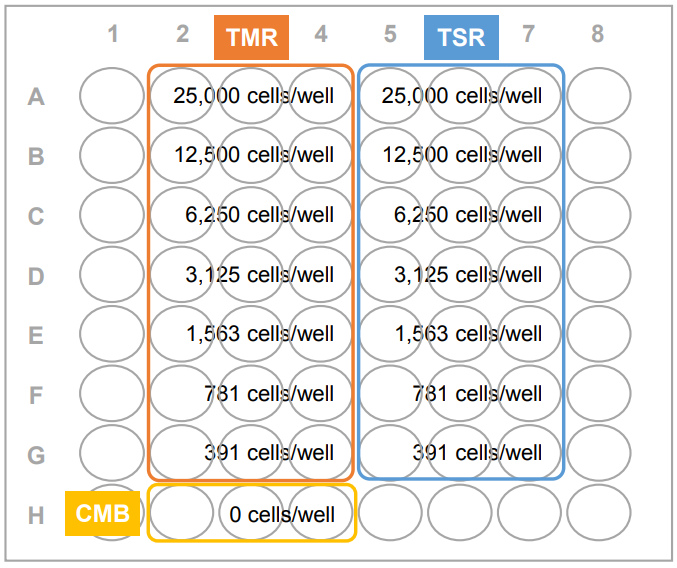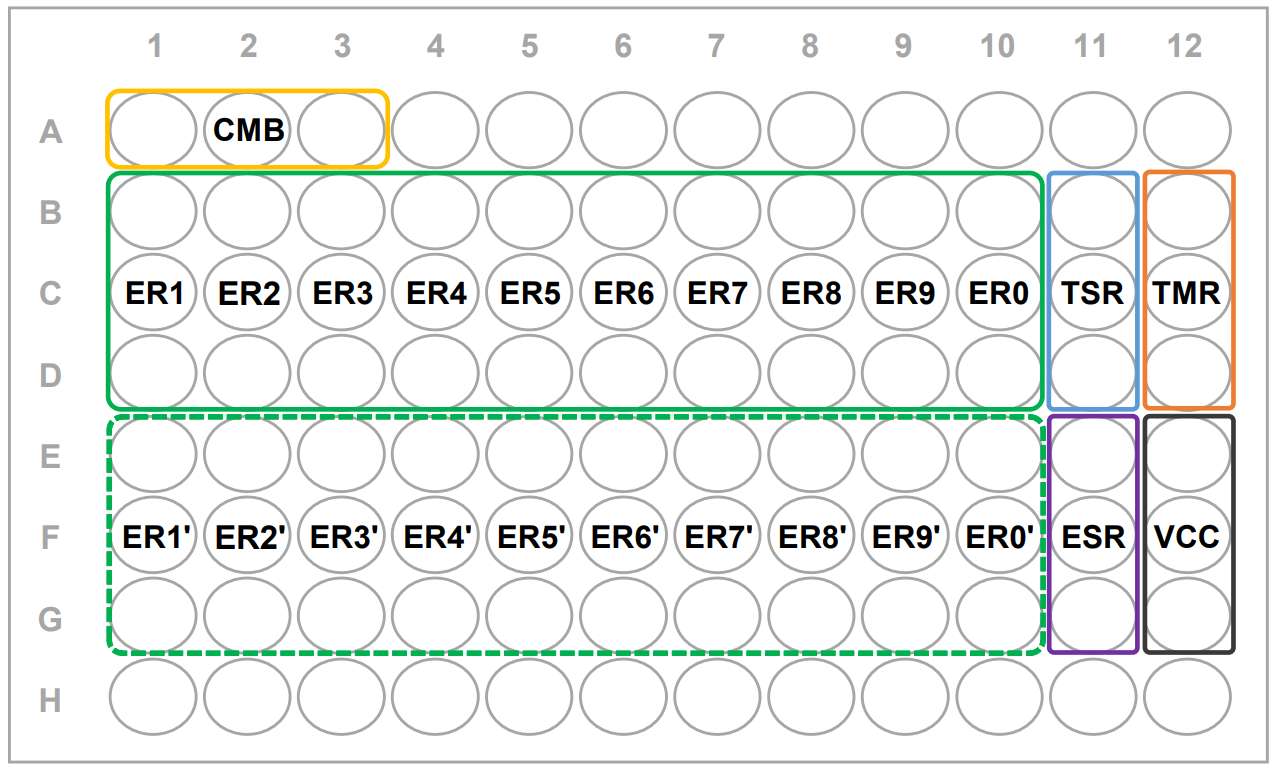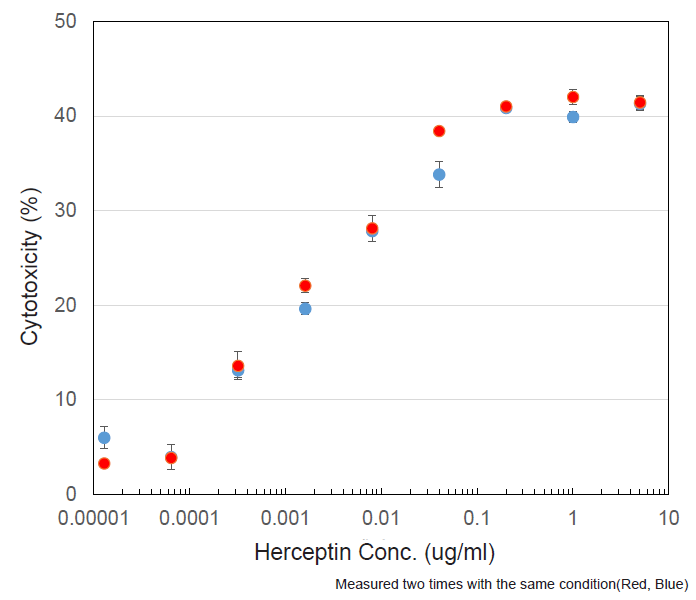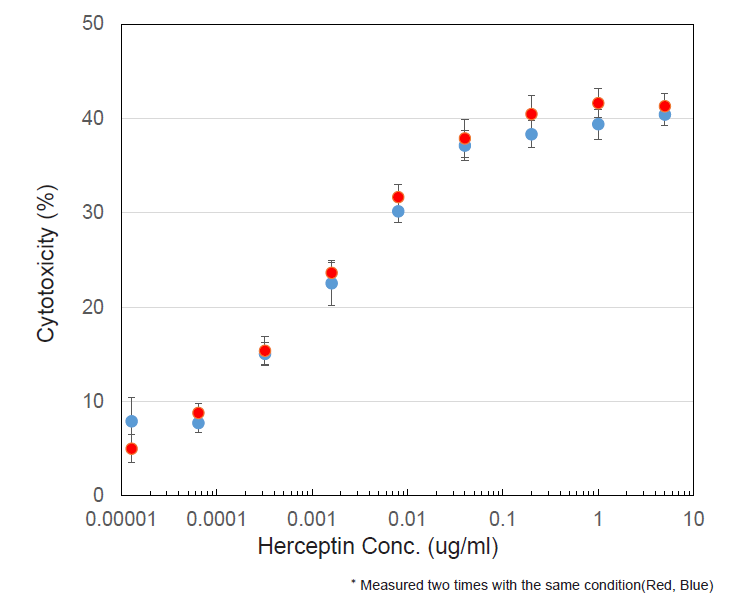Notice to Users
This is a supporting manual for antibody-dependent cell-mediated cytotoxicity (ADCC) assay.
For the contents of this kit and the preparation procedure of Working Solution,
please see the technical manual originally attached to the Cytotoxicity LDH Assay Kit-WST.
For Accurate Measurement
LDH activity can be different depending on the cell type.
Therefore, when cell type is changed, please confirm optimum cell number of target cells before ADCC assay.
| Optimization of cell number |
 |
| ADCC assay |
Selection of the Assay
There are two methods: homogeneous assay and non-homogeneous assay,
please select the assay method according to your experiments.
Homogeneous Assay
Optimization of Cell Number
- After washing target cells with the medium, prepare cell suspension to 5 x 105 cells/ml in the medium.
- Add 100 μl of the medium to each well of 96-well plates.
- In the Row A of 96-well plate (triplicates of TMR(High Control) and TSR (Low Control)) add 100 μl of target cells
prepared in Step 1. and mix by pipetting (2.5 x 104 cells/well). Next, take 100 μl from the Row A and add it to the
Row B. Repeat the serial dilution process as indicated in Figure 1.-
TMR (Target Maximum Release, High Control)
Lysis Buffer is added to the target cells – LDH released from all of the cells.TSR (Target Spontaneous Release, Low Control)
Only medium is added to the target cells – Spontaneous LDH released from the cells.CMB (Culture Medium Background, Background Control)
LDH activity contained in the medium
-

Figure 1 Plate arrangement
-
- Incubate the plate at 37oC in CO2 incubator.
- Use the same incubation time as the ADCC assay.
- Add 10 μl of Lysis Buffer into High Control (TMR) wells.
- Incubate the plate at 37oC for 30 minutes in CO2 incubator.
- Add 100 μl of Working Solution to all of the wells. Protect the plate from light and incubate it at the room temperature for 30 minutes.
- Duration of the color reaction should be optimized based on the target cell types.
- Add 50 μl of Stop Solution to all of the wells.
- Measure the absorbance at 490 nm by a microplate reader.
- Set target cell number per well which satisfies either of below conditions.
A) The difference of TMR and TSR absorbance
( ODTMR - ODTSR ) ≧ 2 × ODCMB
B) Absorbance difference between TMR and TSR at the maximum
C) The absorbance of TMR (ODTMR ) at above 1.0 below 3.0
Preparation of Antibody Solution
Prepare 10 different concentration of antibody solution including zero concentration of antibody solution.
Antibody Solution should be diluted using the medium.
ADCC Assay
Please refer to the plate arrangement (Figure 2) and the amount of solution in each well (Table 1)
Definition of the Wells
|
(Experimental Release): LDH released when all antibody solution, effector cells and target cells are mixed | |
|
(Effector Spontaneous Release): spontaneous release of LDH by effector cells | |
|
(Target Spontaneous Release): spontaneous release of LDH by target cells | |
|
(Target Maximum Release): LDH released from the cells after the addition of Lysis buffer to the target cells | |
|
(Culture Medium Background): LDH contained in the medium | |
|
(Volume Correction Control): LDH from addition of Lysis Buffer in the medium, used for volume correction |

ER’ wells can be used for different type of test substance.
It is recommended to add medium in the Row A and H including CMB wells.
Figure 2 Plate arrangement
| ER | ESR | TSR | TMR | CMB | VCC | |
| Test Substance | 25 µl | - | - | - | - | - |
| Medium | - | 50 µl | 75 µl | 75 µl | 100 µl | 100 µl |
| Effector Cell Solution | 50 µl | 50 µl | - | - | - | - |
| Target Cell Solution | 25 µl | - | 25 µl | 25 µl | - | - |
| Lysis Buffer | - | - | - | 10 µl | - | 10 µl |
General Protocol
Add each different concentration antibody solution into ER wells.
↓
Add Target Cell solution into ER, TMR, and TSR wells.
↓
Add Effector Cell solution into ER and ESR wells.
↓
Add Medium into ESR, TSR, TMR, CMB, and VCC wells.
↓
Centrifuge at 250 x g for 4 minutes.
↓
Incubate 37oC in CO2 incubator for an appropriate time.
↓
Add Lysis buffer to TMR and VCC wells.
↓
Incubate at 37oC in CO2 incubator for 30 minutes.
↓
Add 100 μl of working solution to all of the well.
↓
Protect the plate from light, and incubate it at room temperature for 30 minutes.
↓
Add 50 μl of stop solution to all of the wells.
↓
Measure the absorbance at 490 nm.
Calculation of Cytotxicity
- Subtract absorbance of CMB from absorbance of ER, ESR, TSR wells.
- Subtract absorbance of VCC from the absorbance of TMR wells.
- Plot the data into the following equation to obtain the cytotoxicity (%).


Experimental Example
ADCC Assay using monolonal antibody Herceptin
Homogenous Assay

| Test Substance: | Herceptin |
| Target Cell (T Cell): | SK-BR-3 (1x104 cells/well) |
| Effector Cell (E Cell): | PBMC (1x105 cells/well) |
| Medium: | RPMI1640 (2% FBS, 1% Antibiotic-antimicotic) |
| Ratio of E Cell and T Cell: | 10:1 |
Non-Homogeneous Assay
Optimization of Cell Number
- After washing target cells with the medium, prepare cell suspension to 5 x 105 cells/ml in the medium.
- Add 100 μl of the medium to each well of 96-well plates.
- In the Row A of 96-well plate (triplicates of TMR(High Control) and TSR (Low Control)) add 100 μl of target cells medium prepared in Step 1. and mix by pipetting (2.5 x 104 cells/well). Next, take 100 μl from the Row A and add it to the Row B. Repeat the serial dilution process as indicated in Figure 3.
-
TMR (Target Maximum Release, High Control)
Lysis Buffer is added to the target cells – LDH released from all of the cells.TSR (Target Spontaneous Release, Low Control)
Only medium is added to the target cells – Spontaneous LDH released from the cells.CMB (Culture Medium Background, Background Control)
LDH activity contained in the medium
-

Figure 3 Plate arrangement
-
- Add 100 μl medium to all of the wells.
- Incubate the plate at 37oC in CO2 incubator.
- Use the same incubation time as the ADCC assay.
- Add 20 μl of Lysis Buffer into High Control (TMR) wells.
- Incubate the plate at 37oC for 30 minutes in CO2 incubator.
- Centrifuge at 250 x g for 4 minutes.
- Remove 100 μl of supernatant from all the wells, and add it to a new 96 well plates for measurement.
- Add 100 μl of Working Solution to all of the wells. Protect the plate from light and incubate it at the room temperature for 30 minutes.
- Duration of the color reaction should be optimized based on the target cell types.
- Add 50 μl of Stop Solution to all of the wells.
- Measure the absorbance at 490 nm by a microplate reader.
- Set target cell number per well which satisfies either of below conditions
A) The difference of TMR and TSR absorbance
(ODTMR - ODTSR ) ≧ 2 × ODCMB
B) Absorbance difference between TMR and TSR at the maximum
C) The absorbance of TMR (ODTMR ) at above 1.0 below 3.0
Preparation of Antibody Solution
Prepare 10 different concentration of antibody solution including zero concentration of antibody solution.
Antibody Solution should be diluted using the medium.
ADCC Assay
Please refer to the plate arrangement (Figure 3) and the amount of solution in each well (Table 2)
Definition of the Wells
|
(Experimental Release): LDH released when all antibody solution, effector cells and target cells are mixed | |
|
(Effector Spontaneous Release): spontaneous release of LDH by effector cells | |
|
(Target Spontaneous Release): spontaneous release of LDH by target cells | |
|
(Target Maximum Release): LDH released from the cells after the addition of Lysis buffer to the target cells | |
|
(Culture Medium Background): LDH contained in the medium | |
|
(Volume Correction Control): LDH from addition of Lysis Buffer in the medium, used for volume correction |

ER’ wells can be used for different type of test substance.
It is recommended to add medium in the Row A and H including CMB wells.
Figure 4 Plate arrangement
| ER | ESR | TSR | TMR | CMB | VCC | |
| Test Substance | 50 µl | - | - | - | - | - |
| Medium | - | 100 µl | 150 µl | 150 µl | 200 µl | 200 µl |
| Effector Cell Solution | 100 µl | 100 µl | - | - | - | - |
| Target Cell Solution | 50 µl | - | 50 µl | 50 µl | - | - |
| Lysis Buffer | - | - | - | 20 µl | - | 20 µl |
General Protocol
Add each different concentration antibody solution into ER wells.
↓
Add Target Cell solution into ER, TMR, and TSR wells.
↓
Add Effector Cell solution into ER and ESR wells.
↓
Add Medium into ESR, TSR, TMR, CMB, and VCC wells.
↓
Centrifuge at 250 x g for 4 minutes.
↓
Incubate 37oC in CO2 incubator for an appropriate time.
↓
Add Lysis buffer to TMR and VCC wells.
↓
Incubate at 37oC in CO2 incubator for 30 minutes.
↓
Centrifuge at 250 x g for 4 minutes.
↓
Remove 100 μl from each well and add it to a new 96-well plate.
↓
Add 100 μl of working solution to all of the well.
↓
Protect the plate from light, and incubate it at room temperature for 30 minutes.
↓
Add 50 μl of stop solution to all of the wells.
↓
Measure the absorbance at 490 nm.
Calculation of Cytotxicity
- Subtract absorbance of CMB from absorbance of ER, ESR, TSR wells.
- Subtract absorbance of VCC from the absorbance of TMR wells.
- Plot the data into the following equation to obtain the cytotoxicity (%).


Experimental Example
ADCC Assay using monolonal antibody Herceptin
Non-Homogeneous Assay

| est Substance: | Herceptin |
| Target Cell (T Cell): | SK-BR-3 (1x104 cells/well) |
| Effector Cell (E Cell): | PBMC (1x105 cells/well) |
| Medium: | RPMI1640 (2% FBS, 1% Antibiotic-antimicotic) |
| Ratio of E Cell and T Cell: | 10:1 |
CK12_ADCC: Cytotoxicity LDH Assay Kit-WST
Revised Oct., 05, 2023


 Hidden sections will not be printed.
Hidden sections will not be printed.